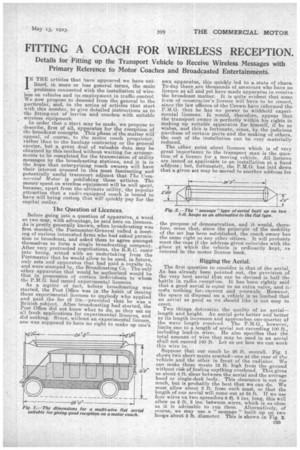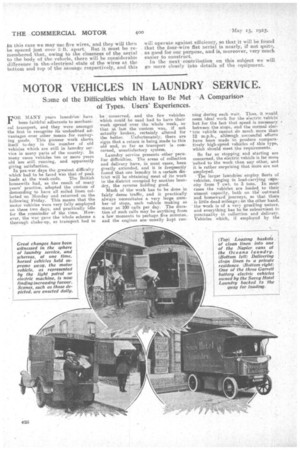FITTING A COACH FOR WIRELESS RECEPTION.
Page 11

Page 12

If you've noticed an error in this article please click here to report it so we can fix it.
Details for Fitting up the Transport Vehicle to Receive Wireless Messages with Primary Reference to Motor Coaches and Broadcasted Entertainments.
IN THE articles that have appeared we have outlined, in more or less general terms, the main problems connected with the installation of wireless on vehicles and its employinent in traffic control. We now propose to descend from the general to the particular, and, in the series of articles that start with this number, to give detailed instructions as to the, fitting-out of lorries and coaches with suitable wireless equipment. In order that a start may be made, we propose to describe, first of all, apparatus for the reception of the broadcast concerts. This phase of the matter will appeal, of course, to the motor coach proprietor, rather than to the haulage. contractor or the general carrier, but a great deal of valuable data may be obtained by this method without waiting for arrangements to be completed for the transmission of utility messages by the broadcasting stations, and it is in the hope that enterprising coach owners will have their interest aroused in this most fascinating and potentially useful transnort adjunct that The Commercial k otor is publishing these articles. The money spent on wireless equipment will be well spent, because, apart from the ultimate utility, the popular attraction that a radio-equipped coach is hound to have will bring custony that. will quickly pay for the capital outlay.
I he Question of Licences.
Before going into a question of apparatus, a word or two may, with advantage, be said here on licences. As is pretty generally known, when broadcasting was first mooted, the Postmaster-General called a meeting of various interested firms who had asked permission to broadcast, and asked them to agree amongst themselves to form a single broadcasting company. After very protracted negotiations, the B.B.C. came into being, armed with an undertaking from the Postmaster that he would allow to be used, in future, only sets and apparatus that had paid a royalty to, and were stamped by, the Broadcasting Co. The only other apparatus that would, be authorized would be that in possession of certain individuals to whom the P.M.G. had issued experimental licences. As a matter of fact, before broadcasting was started, the Post Office was in the habit of issuing these experimental licences to anybody who applied and paid the fee of 10s.—provided that he was a British subject. After broadcasting had started, the Post Office did not know what to do, so they sat on all fresh applications for experimental licences, and did nothing. Since, without an experimental licence, one was supposed to have no right to make up one's own apparatus, this quickly led to a state of chaos. To-day there ,are thousands of amateurs who have no licence at all and yet have made apparatus to receive the broadcast matter. It is quite evident that some form of constructor's licence will have to be issued, since the law officers of -the Crown have informed the P.M.G. that he has no power to withhold experimental licences. It would, therefore, appear that the transport owner is perfectly within his rights in making up suitable apparatus for himself, if he so wishes, and this is fortunate, since, by the judicious purchase of certain mists and the making of others, the cost of the installation can be very materially reduced.
The other point about licences which is of very great importance to the transport man is the question of a licence for a moving vehicle. All licences are issued as applicable to an installation at a fixed address ; but, fortunately, the P.M.G. has laid down that a given set may be moved to another address for
the purpose of demonstration, and it would, therefore, seem that, since the principle of the mobility of the set has been established, the coach owner has the same right as any other citizen. It will probably meet the case if the address given coincides with the ...place at which the vehicle is ordinarily kept, as entered in the motor licence book.
Rigging the Aerial.
The first question to consider is that of the aerial. As has already been pointed out, the provision of the very best aerial that can he devised is half the i battle n radio reception. It has been rightly said that a good aerial is equal to an extra valve, and it costs nothing for. current and renewals. However, the space at disposal on a vehicle is so limited that an aerial as good as we should like is not easy to erect.
Two things determine the quality of an aerial— length and height. An aerial gets better and better as its length increases and approaches one-quarter Qf the wave length received. The P.M.G.1 however, limits one to a length of aerial not exceeding 100 ft., including lead-in wires. He also specifies that the total amount of wire that may be used in an aerial shall not exceed 140 ft. Let us see how we can work this wire in.
Suppose that our coach be 28 It. overall. Fig. 1 shows two short masts erected—one at the rear of the vehicle and the other in front of the radiator. We can make these masts 12 ft. high from the ground without risk of fouling anything overhead. This gives us about 4 ft. clear between the aerial and the average hood or single-deck body. This clearance is not too much, but is probably the best that we can do. We must allow about 2 ft. from each mast, so that the length of our aerial will come out at 24 ft. If we use four wires on two spreaders 6 ft. 6 ins, long, this will allow us 2 ft. 2 ins. between wires, which is as close as it is advisable to run them. Alternatively-, of course, we may use a " sausage " built up on two hoops about 5 ft. diameter. This is shown in Fig. 2. In this case we may use five wires, and they will then be spaced just over 3 ,ft. apart. But it must be remembered that, owing to the closeness of the aerial to the body of the vehicle, there will be considerable difference in the-electrical state of the wires at the bottom and top of the sausage respectively, and this will operate against efficiency' so that it will be found that the four-wire flat aerial is nearly, if not quite, as good for our purpose, and is, moreover, very much easier to construct.
in the next contribution on this subject we will go more closely into details of the equipment.






























